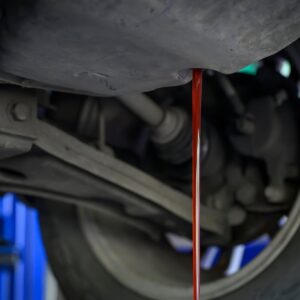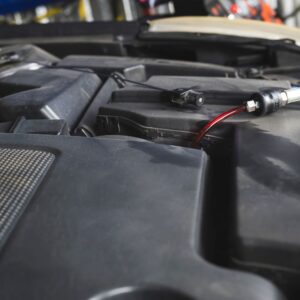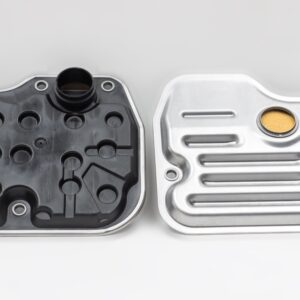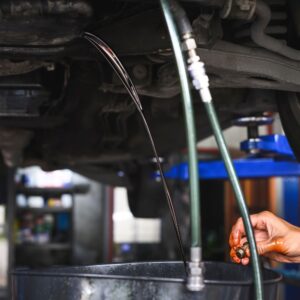Changing transmission fluid isn’t glamorous, but it’s one of those line-items that quietly preserves shift quality, lowers heat, and delays expensive failures. The price you pay depends on the fluid your transmission needs, how much of it the service actually replaces, and whether your gearbox has extra requirements like a replaceable filter or temperature-specific fill procedure.
If you’ve already read conflicting advice about “lifetime” fluid, flush machines, and 40k-mile DSG services, you’re not imagining things—different transmissions really do have different rules. Below is a concise, research-driven breakdown you can use to budget smartly, choose the right type of service, and time it correctly for your transmission.
What does it actually cost?
For a conventional drain-and-fill (often called a “fluid change”), national estimates cluster around $120–$300 for many mainstream vehicles, with model-specific averages like $205–$287 showing up in pricing data (labor + fluid). A full-system exchange/“flush” typically runs about $150–$250 for many cars, sometimes more due to the extra fluid used. Performance or specialty gearboxes—most famously VW/Audi DSG dual-clutch units—regularly come in higher, roughly $500–$800 because they specify premium fluid, filters, and a time-based service interval (e.g., 40k miles on common variants).
Two important points: first, the gearbox fluid change cost rises with fluid capacity (how many quarts the service replaces), and second, “flush” quotes look cheaper until you realize they consume two to three times more fluid than a pan drain, which is where the bill often creeps. Typical exchanges use 12–22 quarts vs. 5–7 quarts for a drain-and-fill.
Why Prices Vary So Much (and Where Shops Add Margin)
Fluid specification dictates both price and availability. Automakers don’t just call for “ATF”; they approve specific formulations—Dexron VI, Mercon LV, ATF+4, ultra-low-viscosity fluids for 9/10-speed boxes, and proprietary CVT blends. Using the correct spec matters more than brand; mixing the wrong type can cause shift quality issues or accelerated wear. Expect premium synthetic or OEM-approved fluids to cost more per quart.
Capacity is the second lever. An exchange replaces nearly all fluid (including what sits in the torque converter and cooler lines), so the parts line item may triple even if labor doesn’t.
Shops also tack on filter, pan gasket, shop supplies, and waste-oil disposal where applicable. If your transmission requires a temperature-controlled fill and level check (common on “sealed” units), labor time increases slightly because the tech must monitor ATF temperature via scan tool. (DIYers will recognize this from Toyota/Aisin and ZF procedures.)
Tip: Ask the shop to print the fluid specification they plan to use and the exact quantity billed. That one question often prevents unnecessary upsells.
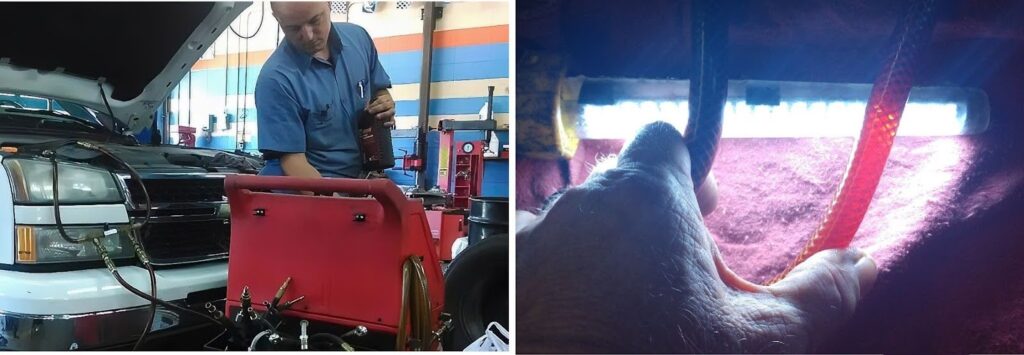
Change vs. Flush vs. Exchange: How to Choose
A drain-and-fill replaces what’s in the pan and refreshes the additive package; an exchange (often called a flush) cycles new fluid through cooler lines to replace most of what the converter holds. Neither is inherently “better”; the right choice depends on condition and history.
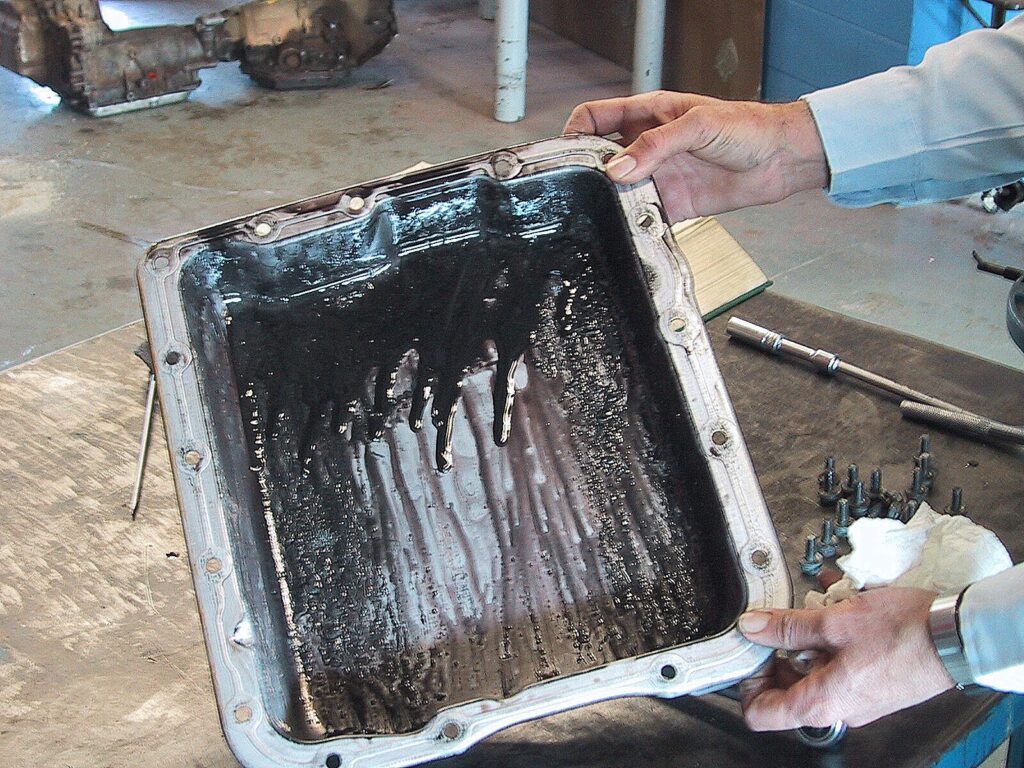
- Choose drain-and-fill when fluid is mildly dark but not burnt, or when you’re servicing on-schedule. It’s gentler, uses less fluid, and is easy to repeat in stages to increase the percentage of new fluid.
- Choose a full exchange when fluid is very degraded but the transmission still shifts normally, or when the manufacturer specifically recommends a machine-assisted exchange.
Most modern machines are designed to use the transmission’s own pump pressure, not shop air, so they don’t “blast” the internals; however, exchanges still consume more fluid and cost more. If the pan hasn’t been down in a long time, include a new filter and a pan inspection with either service to catch debris early.
Warning: If fluid smells burnt or the unit is already slipping, any service is a gamble. Fresh detergents can reveal pre-existing clutch wear. Get a diagnosis first.
Proper Service Intervals
Mileage intervals vary by transmission type and duty cycle. Use your owner’s manual first, then sanity-check with the patterns below:
- Traditional automatics (torque-converter AT): commonly 30k–60k miles under severe service; some OEMs allow longer under ideal conditions. If towing, frequent short trips, or extreme heat apply, stay on the shorter end.
- CVT (continuously variable) fluid is different and often more sensitive to heat; periodic changes are recommended and sometimes called out explicitly by OEMs (Nissan publishes CVT fluid inspection/change guidance by model/year). Use only the specified CVT fluid.
- Dual-clutch (DSG/DCT): several VW/Audi gearboxes specify 40k-mile services (fluid + sometimes filter). Others vary (some 7-speeds go longer), so check your code. Budget accordingly; these use pricier fluids and procedures.
Manual transmissions have their own manual-gear oil spec and interval; don’t assume it matches the automatic transmission fluid cost or cadence.
Vehicles like the BMW 3 Series (F30), Toyota Camry (with Aisin UB80E), Mercedes-Benz E-Class (W213), Honda Accord 2.0T, and Audi A4 (B9) come equipped with transmissions that use “lifetime” transmission fluid.
That being said, some of those platforms have developed high-mileage-related shifting issues that were repaired by simply doing a full fluid exchange and where possible, replacing the filter.
DIY vs. Shop: What You’ll Really Spend
Doing a simple drain-and-fill at home can save labor and let you control fluid brand. Expect roughly:
Parts estimate: 5–7 quarts of the correct fluid, new crush washer, pan gasket and filter if applicable.
Tools you’ll actually use:
- Floor jack and stands (or ramps)
- Large drain pan
- Torque wrench
- Fluid transfer pump or long funnel
- Scan tool capable of reading transmission fluid temperature (for sealed/overflow-tube fills)
- Safety glasses, gloves, absorbent (cat litter works)
If you own a DSG/DCT or a unit with a temperature-specific fill and adaptation, weigh shop service more seriously; those jobs often require special adapters, level procedures, and post-service checks that are easy to botch and hard on the transmission. On the flip side, many conventional automatics are DIY-friendly if you follow the temp spec and torque the pan evenly.
Basic Drain-and-Fill (Conventional Automatics)
- Warm the car with a short drive to bring ATF near its specified temperature window.
- Raise and secure the vehicle level; set a large drain pan under the transmission.
- Remove the drain plug (if equipped) or loosen pan bolts carefully and drain.
- If servicing the filter, drop the pan, clean it, replace the filter and gasket, and reinstall to spec.
- Add the measured amount of new fluid through the fill port or dipstick.
- Start the engine, cycle through gears, and check for leaks.
- With a scan tool, verify ATF temperature and set the final fluid level per the factory procedure (dipstick or overflow plug).
Tip: Save the first drain in a marked jug to measure what came out; it’s the simplest way to avoid overfilling on re-fill.
Picking the Right Fluid
ATF isn’t generic motor oil; it’s a specification with friction behavior tuned to a given valve body, clutch pack material, and software. Examples: Dexron VI for many GM units, Mercon LV for many late-model Fords, ATF+4 for many Stellantis applications, ULV fluids for some 9- and 10-speeds, and dedicated CVT fluids. Unless the fluid explicitly meets your OEM spec, pass. If you see a shop topping an AT with “CVT fluid” or vice versa, that’s a red flag worth walking away over.
Note: Some exchanges advertise a “cleaning solution.” If your OEM doesn’t call for it, skip it; fresh, correct-spec fluid is the safe detergent.
When Rising Automatic Transmission Fluid Cost is Worth It, And When to Save
- Pay more for OEM-approved fluid and a filter/pan service when you’ve gone long between changes or you’re addressing a shift complaint that isn’t yet severe. That inspection time can catch metal or clutch material early.
- Save with staged drain-and-fills a few hundred miles apart if the fluid is old but not burnt; you’ll approach the “percent new” of a machine exchange without the big up-front fluid bill. (This practice is common among experienced owners’ communities.)
Signs You Shouldn’t Delay Service
If you notice any of the following, get the fluid checked sooner rather than later; each points to heat or lubrication problems that accelerate wear:
- Burnt odor after hills or heavy traffic
- Delayed or harsh engagement when shifting from Park/Neutral
- Slip or flare between gears
- Whine or grind that tracks with gear changes
- Leaking ATF on the driveway, especially at cooler lines or pan
Bottom line on budgeting: for most cars, a routine drain-and-fill falls in the low-hundreds; a machine exchange costs more mainly due to added fluid; and specialty transmissions (DSG/DCT) command premium parts and labor. Verify the fluid spec, the quantity, and whether a filter/pan service is included—those three details explain nearly every price swing you’ll see on an estimate.
Any information provided on this Website is for informational purposes only and is not intended to replace consultation with a professional mechanic. The accuracy and timeliness of the information may change from the time of publication.



